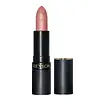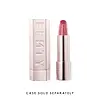Revlon Super Lustrous The Luscious Mattes Lipstick Versus Fenty Beauty Fenty Icon The Fill Semi-Matte Refillable Lipstick
What's inside
What's inside
 Key Ingredients
Key Ingredients

 Benefits
Benefits

 Concerns
Concerns

 Ingredients Side-by-side
Ingredients Side-by-side

Diisopropyl Dimer Dilinoleate
EmollientIsononyl Isononanoate
EmollientOzokerite
Emulsion StabilisingAluminum Starch Octenylsuccinate
AbsorbentOctyldodecyl Neopentanoate
EmollientSilica
AbrasiveMica
Cosmetic ColorantNylon-12
Kaolin
AbrasiveSynthetic Wax
AbrasiveCopernicia Cerifera Cera
EmollientMoringa Oleifera Seed Oil
EmollientTheobroma Grandiflorum Seed Butter
Skin ConditioningCaprylic/Capric Triglyceride
MaskingAgave Rigida Extract
Hydrogenated Polyisobutene
EmollientAnemarrhena Asphodeloides Root Extract
Skin ConditioningCera Microcristallina
Emulsion StabilisingEthylene/Propylene Copolymer
AbrasivePolyethylene
AbrasiveBHT
AntioxidantPhenoxyethanol
PreservativeBlue 1 Lake
Cosmetic ColorantIron Oxides
CI 45410
Cosmetic ColorantCI 17200
Cosmetic ColorantCI 15850
Cosmetic ColorantCI 77891
Cosmetic ColorantCI 19140
Cosmetic ColorantDiisopropyl Dimer Dilinoleate, Isononyl Isononanoate, Ozokerite, Aluminum Starch Octenylsuccinate, Octyldodecyl Neopentanoate, Silica, Mica, Nylon-12, Kaolin, Synthetic Wax, Copernicia Cerifera Cera, Moringa Oleifera Seed Oil, Theobroma Grandiflorum Seed Butter, Caprylic/Capric Triglyceride, Agave Rigida Extract, Hydrogenated Polyisobutene, Anemarrhena Asphodeloides Root Extract, Cera Microcristallina, Ethylene/Propylene Copolymer, Polyethylene, BHT, Phenoxyethanol, Blue 1 Lake, Iron Oxides, CI 45410, CI 17200, CI 15850, CI 77891, CI 19140
Octyldodecanol
EmollientDiisostearyl Malate
EmollientDimethicone
EmollientPolyethylene
AbrasivePentaerythrityl Hydrogenated Rosinate
Aluminum Starch Octenylsuccinate
AbsorbentLauroyl Lysine
Skin ConditioningSilica
AbrasiveNylon-12
Trimethylsiloxysilicate
EmollientPolypropylsilsesquioxane
Hydrated Silica
AbrasiveSynthetic Wax
AbrasiveParfum
MaskingOctyldodecyl Neopentanoate
EmollientDisteardimonium Hectorite
StabilisingWater
Skin ConditioningSorbitan Oleate
EmulsifyingTribehenin
EmollientMica
Cosmetic ColorantCandelilla Cera
EmollientCaprylyl Glycol
EmollientAroma
Propylene Carbonate
SolventHydrolyzed Hyaluronic Acid
HumectantTocopherol
AntioxidantTocopheryl Acetate
AntioxidantTetrahexyldecyl Ascorbate
AntioxidantPentaerythrityl Tetra-Di-T-Butyl Hydroxyhydrocinnamate
AntioxidantCalcium Sodium Borosilicate
Calcium Aluminum Borosilicate
Synthetic Fluorphlogopite
Tin Oxide
AbrasiveBenzyl Benzoate
AntimicrobialLimonene
PerfumingIron Oxides
CI 15850
Cosmetic ColorantCI 77891
Cosmetic ColorantOctyldodecanol, Diisostearyl Malate, Dimethicone, Polyethylene, Pentaerythrityl Hydrogenated Rosinate, Aluminum Starch Octenylsuccinate, Lauroyl Lysine, Silica, Nylon-12, Trimethylsiloxysilicate, Polypropylsilsesquioxane, Hydrated Silica, Synthetic Wax, Parfum, Octyldodecyl Neopentanoate, Disteardimonium Hectorite, Water, Sorbitan Oleate, Tribehenin, Mica, Candelilla Cera, Caprylyl Glycol, Aroma, Propylene Carbonate, Hydrolyzed Hyaluronic Acid, Tocopherol, Tocopheryl Acetate, Tetrahexyldecyl Ascorbate, Pentaerythrityl Tetra-Di-T-Butyl Hydroxyhydrocinnamate, Calcium Sodium Borosilicate, Calcium Aluminum Borosilicate, Synthetic Fluorphlogopite, Tin Oxide, Benzyl Benzoate, Limonene, Iron Oxides, CI 15850, CI 77891
 Reviews
Reviews

Ingredients Explained
These ingredients are found in both products.
Ingredients higher up in an ingredient list are typically present in a larger amount.
Aluminum Starch Octenylsuccinate is a synthetic powder used as an absorbent, thickener, and anti-caking agent.
As an absorbent, it is great at mattifying skin by soaking up the oil. This is why you'll find it in a range of products from makeup to moisturizers.
This ingredient is considered a modified starch. Starch can also be found naturally in plants.
One study from 1991 found that 5% of this ingredient enhanced titanium dioxide SPF by as much as 40%. The study found 1% titanium dioxide had a 5.6 SPF and adding 5% of aluminum starch octenylsuccinate boosted it to an SPF of 8.1
Although “aluminum” in an ingredient name can raise red flags for some consumers, the form and usage context matter significantly. For typical topical applications, there is no substantial evidence of health risks - such as cancer, neurotoxicity, or systemic “aluminum overload.”
Learn more about Aluminum Starch OctenylsuccinateCi 15850 is the pigment color red. It is an azo dye and created synthetically.
Azo dyes need to be thoroughly purified before use. This allows them to be more stable and longer-lasting.
This ingredient is common in foundations, lipsticks, and blushes. This color is described as brown/orangey red.
It has many secondary names such as Red 6 and Red 7. According to a manufacturer, Red 6 usually contains aluminum.
Learn more about CI 15850Ci 77891 is a white pigment from Titanium dioxide. It is naturally found in minerals such as rutile and ilmenite.
It's main function is to add a white color to cosmetics. It can also be mixed with other colors to create different shades.
Ci 77891 is commonly found in sunscreens due to its ability to block UV rays.
Learn more about CI 77891Mica is a naturally occurring mineral used to add shimmer and color in cosmetics. It can also help improve the texture of a product or give it an opaque, white/silver color.
Serecite is the name for very fine but ragged grains of mica.
This ingredient is often coated with metal oxides like titanium dioxide. Trace amounts of heavy metals may be found in mica, but these metals are not harmful in our personal products.
Mica has been used since prehistoric times throughout the world. Ancient Egyptian, Indian, Greek, Roman, Aztec, and Chinese civilizations have used mica.
Learn more about MicaNylon-12 is a polymer. It is derived from 12-aminododecanoic acid, an omega-amino fatty acid
According to a manufacturer, it is a talc substitute. Like talc, nylon-12 gives products a satin feel. The manufacturer also claims this ingredients does not block pores and has moderate oil absorption.
This ingredient may not be reef-safe.
Learn more about Nylon-12We don't have a description for Octyldodecyl Neopentanoate yet.
Polyethylene is a synthetic ingredient that helps the skin retain moisture. It is a polymer.
It is also typically used within product formulations to help bind solid ingredients together and thicken oil-based ingredients. When added to balms and emulsions, it helps increase the melting point temperature.
Silica, also known as silicon dioxide, is a naturally occurring mineral. It is used as a fine, spherical, and porous powder in cosmetics.
Though it has exfoliant properties, the function of silica varies depending on the product.
The unique structure of silica enhances the spreadability and adds smoothness, making it a great texture enhancer.
It is also used as an active carrier, emulsifier, and mattifier due to its ability to absorb excess oil.
In some products, tiny microneedles called spicules are made from silica or hydrolyzed sponge. When you rub them in, they lightly polish away dead skin layers and enhance the penetration of active ingredients.
Learn more about SilicaSynthetic Wax is created from fossil fuels such as natural gas. It is used to enhance texture, adjust pH, and as an occlusive.
It may also be used as an abrasive ingredient to exfoliate the skin.
Synthetic Wax may not be fungal acne safe.
Learn more about Synthetic WaxThis ingredient is a combination of red, black, and yellow iron oxide pigments. This combination of colors is usually found in foundation, because it results in a "skin" color.